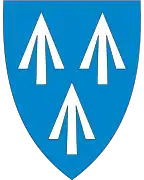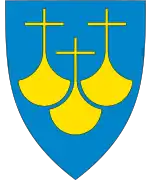Hareid
Hareid is a municipality in Møre og Romsdal county, Norway. It is part of the Sunnmøre region. The administrative centre is the village of Hareid. The other main population centers are Brandal and Hjørungavåg.
Hareid kommune | |
|---|---|
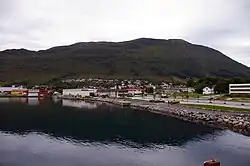 | |
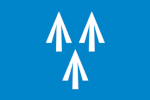 Flag  Møre og Romsdal within Norway | |
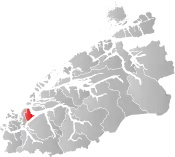 Hareid within Møre og Romsdal | |
| Coordinates: 62°21′51″N 06°00′05″E | |
| Country | Norway |
| County | Møre og Romsdal |
| District | Sunnmøre |
| Established | 1 Jan 1917 |
| • Preceded by | Ulstein Municipality |
| Administrative centre | Hareid |
| Government | |
| • Mayor (2019) | Bernt Brandal (LL) |
| Area | |
| • Total | 82.28 km2 (31.77 sq mi) |
| • Land | 76.83 km2 (29.66 sq mi) |
| • Water | 5.45 km2 (2.10 sq mi) 6.6% |
| • Rank | #336 in Norway |
| Population (2022) | |
| • Total | 5,126 |
| • Rank | #180 in Norway |
| • Density | 66.7/km2 (173/sq mi) |
| • Change (10 years) | |
| Demonym | Hareidstøling[1] |
| Official language | |
| • Norwegian form | Nynorsk |
| Time zone | UTC+01:00 (CET) |
| • Summer (DST) | UTC+02:00 (CEST) |
| ISO 3166 code | NO-1517 |
| Website | Official website |
The municipality is situated off the mainland coast of Sunnmøre, on an island named Hareidlandet, which it shared with Ulstein Municipality, the commercial capital of the area. Hareid is regarded as the cultural capital with its annual Hareidsstemne and many choirs. It is also an important traffic hub in Sunnmøre and is connected by ferry to the neighboring island of Sula which in turn is connected to the city of Ålesund and the island of Valderøya. The municipality is connected to the mainland via the Eiksund Bridge and Eiksund Tunnel through Ulstein.
The 82-square-kilometre (32 sq mi) municipality is the 336th largest by area out of the 356 municipalities in Norway. Hareid is the 180th most populous municipality in Norway with a population of 5,126. The municipality's population density is 66.7 inhabitants per square kilometre (173/sq mi) and its population has increased by 2.5% over the previous 10-year period.[3][4]
General information
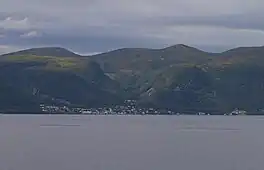
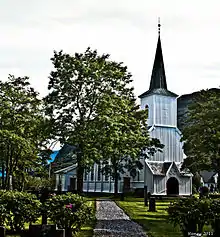
The municipality of Hareid was established on 1 January 1917 when it was separated from Ulstein Municipality to form a municipality of its own. Originally, the municipality included the eastern part of Hareidlandet island and the southwestern part of the nearby island of Sula. The initial population of the municipality was 2,310. On 1 July 1958, the southwestern part of the island of Sula (population: 68) was transferred from Hareid Municipality to Borgund Municipality.[5]
Name
The municipality (originally the parish) is named after the old Hareid farm (Old Norse: Haðareið), since the first Hareid Church was built there. The first element is the genitive case of the name of the island Hǫð (now Hareidlandet). The meaning of the old island name is uncertain, but it is speculated that it might be connected to the Norse god, Höðr. The last element is eið which means "isthmus".[6]
Coat of arms
The coat of arms was granted on 11 January 1985. The official blazon is "Azure, three arrowheads argent points to chief" (Norwegian: På blå grunn tre opprette sølv piloddar, to over ein). This means the arms have a blue field (background) and the charge is three arrowhead symbols that are pointing upwards. The charge has a tincture of argent which means it is commonly colored white, but if it is made out of metal, then silver is used. The arrowheads were chosen as a symbol for the Battle of Hjörungavágr in 986, in which Earl Håkon defeated the Danish Vikings. This battle played an important role in the struggle by Håkon to unite the whole of Norway. Since the battle took place in the municipality, the arrowheads were considered an appropriate symbol. The arms were designed by Jarle Skuseth. The municipal flag has the same design as the coat of arms.[7][8][9]
Churches
The Church of Norway has one parish (sokn) within the municipality of Hareid. It is part of the Søre Sunnmøre prosti (deanery) in the Diocese of Møre.
| Parish (sokn) | Church name | Location of the church | Year built |
|---|---|---|---|
| Hareid | Hareid Church | Hareid | 1877 |
Government
All municipalities in Norway are responsible for primary education (through 10th grade), outpatient health services, senior citizen services, welfare and other social services, zoning, economic development, and municipal roads and utilities. The municipality is governed by a municipal council of directly elected representatives. The mayor is indirectly elected by a vote of the municipal council.[10] The municipality falls under the Møre og Romsdal District Court and the Frostating Court of Appeal.
Municipal council
The municipal council (Kommunestyre) of Hareid is made up of 21 representatives that are elected to four year terms. The party breakdown of the council is as follows:
| Party Name (in Nynorsk) | Number of representatives | |
|---|---|---|
| Labour Party (Arbeidarpartiet) | 3 | |
| Progress Party (Framstegspartiet) | 7 | |
| Conservative Party (Høgre) | 2 | |
| Christian Democratic Party (Kristeleg Folkeparti) | 1 | |
| Liberal Party (Venstre) | 3 | |
| People's list for Hareid (Folkelista for Hareid) | 5 | |
| Total number of members: | 21 | |
| Party Name (in Nynorsk) | Number of representatives | |
|---|---|---|
| Labour Party (Arbeidarpartiet) | 3 | |
| Progress Party (Framstegspartiet) | 4 | |
| Conservative Party (Høgre) | 5 | |
| Christian Democratic Party (Kristeleg Folkeparti) | 2 | |
| Liberal Party (Venstre) | 2 | |
| People's list for Hareid (Folkelista for Hareid) | 5 | |
| Total number of members: | 21 | |
| Party Name (in Nynorsk) | Number of representatives | |
|---|---|---|
| Labour Party (Arbeidarpartiet) | 2 | |
| Progress Party (Framstegspartiet) | 4 | |
| Conservative Party (Høgre) | 5 | |
| Christian Democratic Party (Kristeleg Folkeparti) | 2 | |
| Liberal Party (Venstre) | 3 | |
| People's list for Hareid (Folkelista for Hareid) | 5 | |
| Total number of members: | 21 | |
| Party Name (in Nynorsk) | Number of representatives | |
|---|---|---|
| Labour Party (Arbeidarpartiet) | 3 | |
| Progress Party (Framstegspartiet) | 4 | |
| Conservative Party (Høgre) | 4 | |
| Christian Democratic Party (Kristeleg Folkeparti) | 1 | |
| Socialist Left Party (Sosialistisk Venstreparti) | 1 | |
| Liberal Party (Venstre) | 3 | |
| People's list for Hareid municipality (Folkelista for Hareid kommune) | 5 | |
| Total number of members: | 21 | |
| Party Name (in Nynorsk) | Number of representatives | |
|---|---|---|
| Labour Party (Arbeidarpartiet) | 2 | |
| Progress Party (Framstegspartiet) | 7 | |
| Conservative Party (Høgre) | 3 | |
| Christian Democratic Party (Kristeleg Folkeparti) | 2 | |
| Socialist Left Party (Sosialistisk Venstreparti) | 1 | |
| Liberal Party (Venstre) | 7 | |
| Cross-party election list in Hareid (Tverrpolitisk valliste i Hareid) | 3 | |
| Total number of members: | 25 | |
| Party Name (in Nynorsk) | Number of representatives | |
|---|---|---|
| Labour Party (Arbeidarpartiet) | 2 | |
| Progress Party (Framstegspartiet) | 5 | |
| Conservative Party (Høgre) | 4 | |
| Christian Democratic Party (Kristeleg Folkeparti) | 3 | |
| Centre Party (Senterpartiet) | 1 | |
| Socialist Left Party (Sosialistisk Venstreparti) | 1 | |
| Liberal Party (Venstre) | 5 | |
| Cross-party list (Tverrpolitisk liste) | 4 | |
| Total number of members: | 25 | |
| Party Name (in Nynorsk) | Number of representatives | |
|---|---|---|
| Labour Party (Arbeidarpartiet) | 3 | |
| Progress Party (Framstegspartiet) | 4 | |
| Conservative Party (Høgre) | 4 | |
| Christian Democratic Party (Kristeleg Folkeparti) | 3 | |
| Centre Party (Senterpartiet) | 2 | |
| Socialist Left Party (Sosialistisk Venstreparti) | 1 | |
| Liberal Party (Venstre) | 2 | |
| Cross-party list (Tverrpolitisk liste) | 6 | |
| Total number of members: | 25 | |
| Party Name (in Nynorsk) | Number of representatives | |
|---|---|---|
| Labour Party (Arbeidarpartiet) | 4 | |
| Progress Party (Framstegspartiet) | 2 | |
| Conservative Party (Høgre) | 2 | |
| Christian Democratic Party (Kristeleg Folkeparti) | 3 | |
| Centre Party (Senterpartiet) | 2 | |
| Socialist Left Party (Sosialistisk Venstreparti) | 1 | |
| Liberal Party (Venstre) | 2 | |
| Cross-party list (Tverrpolitisk liste) | 9 | |
| Total number of members: | 25 | |
| Party Name (in Nynorsk) | Number of representatives | |
|---|---|---|
| Labour Party (Arbeidarpartiet) | 4 | |
| Conservative Party (Høgre) | 6 | |
| Christian Democratic Party (Kristeleg Folkeparti) | 5 | |
| Centre Party (Senterpartiet) | 2 | |
| Socialist Left Party (Sosialistisk Venstreparti) | 1 | |
| Liberal Party (Venstre) | 7 | |
| Total number of members: | 25 | |
| Party Name (in Nynorsk) | Number of representatives | |
|---|---|---|
| Labour Party (Arbeidarpartiet) | 4 | |
| Conservative Party (Høgre) | 7 | |
| Christian Democratic Party (Kristeleg Folkeparti) | 5 | |
| Centre Party (Senterpartiet) | 2 | |
| Socialist Left Party (Sosialistisk Venstreparti) | 1 | |
| Liberal Party (Venstre) | 6 | |
| Total number of members: | 25 | |
| Party Name (in Nynorsk) | Number of representatives | |
|---|---|---|
| Labour Party (Arbeidarpartiet) | 3 | |
| Conservative Party (Høgre) | 6 | |
| Christian Democratic Party (Kristeleg Folkeparti) | 5 | |
| Centre Party (Senterpartiet) | 2 | |
| Liberal Party (Venstre) | 5 | |
| Total number of members: | 21 | |
| Party Name (in Nynorsk) | Number of representatives | |
|---|---|---|
| Labour Party (Arbeidarpartiet) | 3 | |
| Conservative Party (Høgre) | 5 | |
| Christian Democratic Party (Kristeleg Folkeparti) | 5 | |
| Centre Party (Senterpartiet) | 4 | |
| Liberal Party (Venstre) | 4 | |
| Total number of members: | 21 | |
| Party Name (in Nynorsk) | Number of representatives | |
|---|---|---|
| Labour Party (Arbeidarpartiet) | 4 | |
| Conservative Party (Høgre) | 3 | |
| Christian Democratic Party (Kristeleg Folkeparti) | 4 | |
| Centre Party (Senterpartiet) | 2 | |
| Liberal Party (Venstre) | 4 | |
| Local List(s) (Lokale lister) | 4 | |
| Total number of members: | 21 | |
| Party Name (in Nynorsk) | Number of representatives | |
|---|---|---|
| Labour Party (Arbeidarpartiet) | 4 | |
| Conservative Party (Høgre) | 3 | |
| Christian Democratic Party (Kristeleg Folkeparti) | 5 | |
| Centre Party (Senterpartiet) | 2 | |
| Liberal Party (Venstre) | 5 | |
| Local List(s) (Lokale lister) | 2 | |
| Total number of members: | 21 | |
| Party Name (in Nynorsk) | Number of representatives | |
|---|---|---|
| Labour Party (Arbeidarpartiet) | 3 | |
| Conservative Party (Høgre) | 2 | |
| Christian Democratic Party (Kristeleg Folkeparti) | 5 | |
| Centre Party (Senterpartiet) | 3 | |
| Liberal Party (Venstre) | 6 | |
| Local List(s) (Lokale lister) | 2 | |
| Total number of members: | 21 | |
| Party Name (in Nynorsk) | Number of representatives | |
|---|---|---|
| Labour Party (Arbeidarpartiet) | 1 | |
| Local List(s) (Lokale lister) | 20 | |
| Total number of members: | 21 | |
| Party Name (in Nynorsk) | Number of representatives | |
|---|---|---|
| Labour Party (Arbeidarpartiet) | 2 | |
| Local List(s) (Lokale lister) | 19 | |
| Total number of members: | 21 | |
| Party Name (in Nynorsk) | Number of representatives | |
|---|---|---|
| Labour Party (Arbeidarpartiet) | 3 | |
| Local List(s) (Lokale lister) | 17 | |
| Total number of members: | 20 | |
| Party Name (in Nynorsk) | Number of representatives | |
|---|---|---|
| Labour Party (Arbeidarpartiet) | 3 | |
| Local List(s) (Lokale lister) | 17 | |
| Total number of members: | 20 | |
| Party Name (in Nynorsk) | Number of representatives | |
|---|---|---|
| Labour Party (Arbeidarpartiet) | 3 | |
| Local List(s) (Lokale lister) | 17 | |
| Total number of members: | 20 | |
| Party Name (in Nynorsk) | Number of representatives | |
|---|---|---|
| Labour Party (Arbeidarpartiet) | 4 | |
| Local List(s) (Lokale lister) | 16 | |
| Total number of members: | 20 | |
| Note: Due to the German occupation of Norway during World War II, no elections were held for new municipal councils until after the war ended in 1945. | ||
Mayors
The mayors of Hareid:
- 1917-1925: Arne I. Grimstad
- 1926-1941: Randulf R. Rise
- 1941-1942: Hans Dybhavn (NS)
- 1942-1945: Asbjørn Riise (NS)
- 1945-1945: Bernhard Harkjerr
- 1946-1947: Martin Karlsen
- 1948-1951: Joakim P. Måseide
- 1952-1955: Håkon A. Riise (Ap)
- 1956-1967: Sverre A. Riise (Sp)
- 1968-1971: Ola L. Grønevet (V)
- 1972-1976: Endre Hareide (KrF)
- 1976-1983: Einar Holm (V)
- 1984-1987: Olav Fure (KrF)
- 1988-1990: Johan E. Hareide (H)
- 1990-1991: Olav Fure (KrF)
- 1992-1999: Einar Holm (V)
- 1999-2007: Gunn Berit Gjerde (V)
- 2007-2011: Hans Gisle Holstad (Ap)
- 2011-2019: Anders Riise (H)
- 2019–present: Bernt Brandal (LL)
Economy
Primary industries
Primary industries such as fisheries and agriculture have traditionally been important ways of life in Hareid, and continue to be so for some of the population.
Industry
In recent years Hareid has developed into a modern industrial municipality with a variety of industries, including furniture, fish farming, offshore and subsea ship systems, and other manufacturers of ship equipment. Many Hareid companies specialize in manufacturing maritime equipment and components, and are part of the maritime cluster of Sunnmøre. Such clusters are considered by the EU to be powerful engines of economic development and drivers for innovation in Europe.[29]
Industrial companies
- Ekornes (furniture)
- Hareid Group (electrical systems)
- Jets (vacuum sanitation)
- Kvalsvik Produksjon (kitchen furniture)
- Libra Plast (ship doors)
- Norway Pelagic (fish processing plant)
- Rolls-Royce Marine (maritime equipment)
- Spenncon (precast concrete)
- Stromek (maritime equipment)
- Vital Base (specialized pillows and cushions)
Education
The village of Hareid is home to Hareid elementary school and Hareid junior high school, with two more elementary schools in more rural parts of the municipality.
- Hareid elementary school, grades 1 through 7
- Bigset elementary school, grades 1 through 7
- Hjørungavåg elementary school, grades 1 through 7
- Hareid junior high school, grades 8 through 10
After finishing junior high school in Hareid, students can complete a high school education in one of Hareid's neighbouring communities such as Ulsteinvik or Ålesund.
Notable people
- Marie Lovise Widnes (born 1930) a poet, author, singer, composer and local politician in Hareid
- Kjell Magne Yri (born 1943 in Hareid) a Norwegian priest, linguist and translator
- Åge Hareide (born 1953 in Hareid) a former footballer with 266 club caps and 50 for Norway and national team manager for Norway, 2003–2008 & Denmark, 2016–2020
- Fredrik Aursnes (born 1995 in Hareid) a footballer with over 240 club caps
References
- "Navn på steder og personer: Innbyggjarnamn" (in Norwegian). Språkrådet.
- "Forskrift om målvedtak i kommunar og fylkeskommunar" (in Norwegian). Lovdata.no.
- Statistisk sentralbyrå. "Table: 06913: Population 1 January and population changes during the calendar year (M)" (in Norwegian).
- Statistisk sentralbyrå. "09280: Area of land and fresh water (km²) (M)" (in Norwegian).
- Jukvam, Dag (1999). "Historisk oversikt over endringer i kommune- og fylkesinndelingen" (PDF) (in Norwegian). Statistisk sentralbyrå.
- Rygh, Oluf (1908). Norske gaardnavne: Romsdals amt (in Norwegian) (13 ed.). Kristiania, Norge: W. C. Fabritius & sønners bogtrikkeri. p. 56.
- "Civic heraldry of Norway - Norske Kommunevåpen". Heraldry of the World. Retrieved 15 April 2023.
- "Hareid, Møre og Romsdal (Norway)". Flags of the World. Retrieved 15 April 2023.
- "Godkjenning av våpen og flagg". Lovdata.no (in Norwegian). Norges kommunal- og arbeidsdepartementet. 11 January 1985. Retrieved 15 April 2023.
- Hansen, Tore; Vabo, Signy Irene, eds. (20 September 2022). "kommunestyre". Store norske leksikon (in Norwegian). Kunnskapsforlaget. Retrieved 14 October 2022.
- "Tall for Norge: Kommunestyrevalg 2019 - Møre og Romsdal" (in Norwegian). Statistics Norway. Retrieved 19 October 2019.
- "Table: 04813: Members of the local councils, by party/electoral list at the Municipal Council election (M)" (in Norwegian). Statistics Norway.
- "Tall for Norge: Kommunestyrevalg 2011 - Møre og Romsdal" (in Norwegian). Statistics Norway. Retrieved 19 October 2019.
- "Kommunestyrevalget 1995" (PDF) (in Norwegian). Oslo-Kongsvinger: Statistisk sentralbyrå. 1996. Retrieved 1 May 2020.
- "Kommunestyrevalget 1991" (PDF) (in Norwegian). Oslo-Kongsvinger: Statistisk sentralbyrå. 1993. Retrieved 1 May 2020.
- "Kommunestyrevalget 1987" (PDF) (in Norwegian). Oslo-Kongsvinger: Statistisk sentralbyrå. 1988. Retrieved 1 May 2020.
- "Kommunestyrevalget 1983" (PDF) (in Norwegian). Oslo-Kongsvinger: Statistisk sentralbyrå. 1984. Retrieved 1 May 2020.
- "Kommunestyrevalget 1979" (PDF) (in Norwegian). Oslo: Statistisk sentralbyrå. 1979. Retrieved 1 May 2020.
- "Kommunevalgene 1975" (PDF) (in Norwegian). Oslo: Statistisk sentralbyrå. 1977. Retrieved 1 May 2020.
- "Kommunevalgene 1972" (PDF) (in Norwegian). Oslo: Statistisk sentralbyrå. 1973. Retrieved 1 May 2020.
- "Kommunevalgene 1967" (PDF) (in Norwegian). Oslo: Statistisk sentralbyrå. 1967. Retrieved 1 May 2020.
- "Kommunevalgene 1963" (PDF) (in Norwegian). Oslo: Statistisk sentralbyrå. 1964. Retrieved 1 May 2020.
- "Kommunevalgene og Ordførervalgene 1959" (PDF) (in Norwegian). Oslo: Statistisk sentralbyrå. 1960. Retrieved 1 May 2020.
- "Kommunevalgene og Ordførervalgene 1955" (PDF) (in Norwegian). Oslo: Statistisk sentralbyrå. 1957. Retrieved 1 May 2020.
- "Kommunevalgene og Ordførervalgene 1951" (PDF) (in Norwegian). Oslo: Statistisk sentralbyrå. 1952. Retrieved 1 May 2020.
- "Kommunevalgene og Ordførervalgene 1947" (PDF) (in Norwegian). Oslo: Statistisk sentralbyrå. 1948. Retrieved 1 May 2020.
- "Kommunevalgene og Ordførervalgene 1945" (PDF) (in Norwegian). Oslo: Statistisk sentralbyrå. 1947. Retrieved 1 May 2020.
- "Kommunevalgene og Ordførervalgene 1937" (PDF) (in Norwegian). Oslo: Statistisk sentralbyrå. 1938. Retrieved 1 May 2020.
- European Commission Maritime Affairs. "Maritime Clusters". Archived from the original on 19 July 2009. Retrieved 28 October 2010.
External links
- Official municipality website (in Norwegian)
 Media related to Hareid at Wikimedia Commons
Media related to Hareid at Wikimedia Commons Møre og Romsdal travel guide from Wikivoyage
Møre og Romsdal travel guide from Wikivoyage- Municipal fact sheet from Statistics Norway (in Norwegian)
